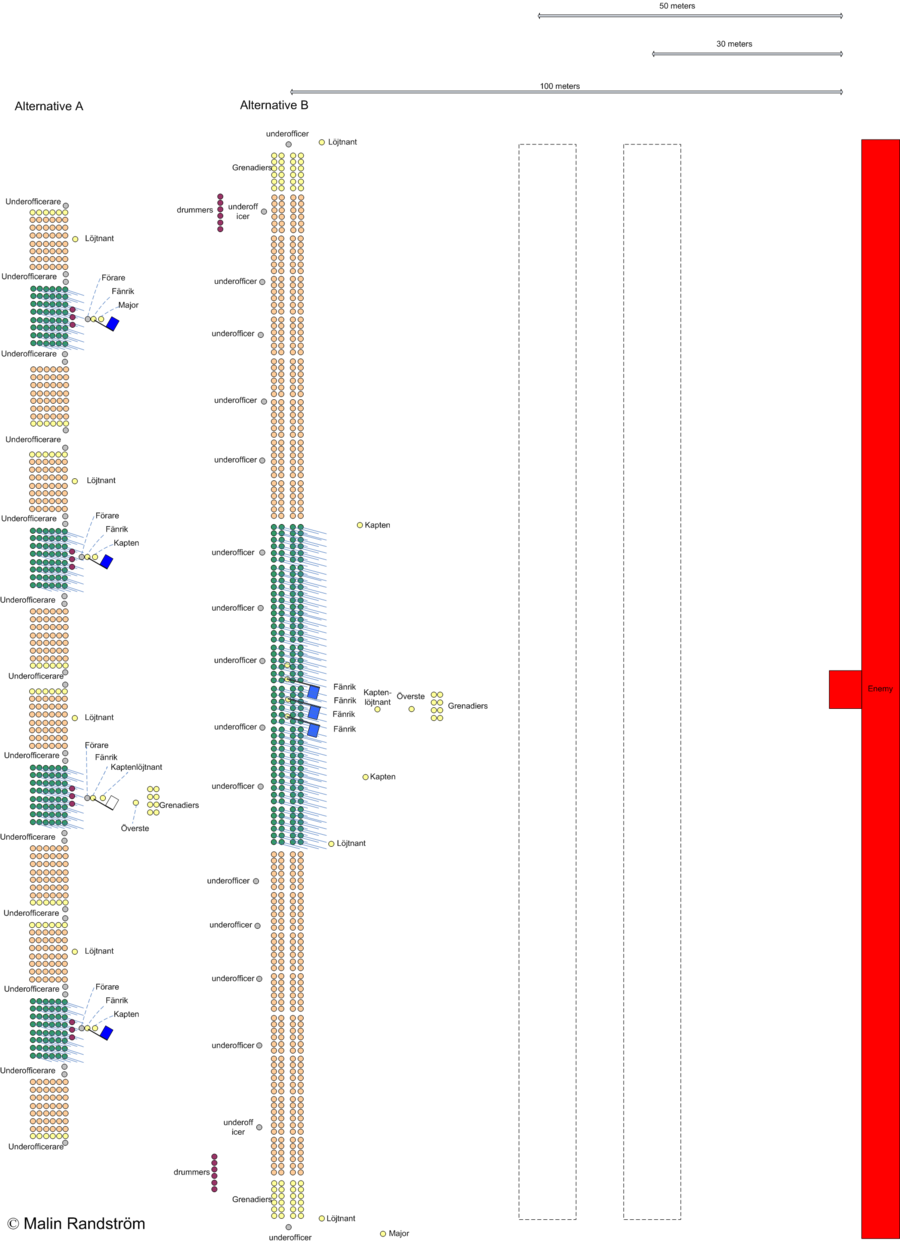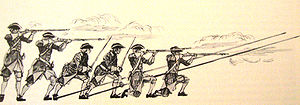.gif)
Battalion (Sweden)
Encyclopedia
A Swedish/Finnish battalion during the mid 17th century up to the mid 18th century was the smallest tactical unit in combat. The 600 man unit was formed, temporarily, at the inception of a battle by joining four foot companies from a foot regiment of eight companies. The commander of the regiment, a Överste
(Colonel
), led the first battalion and his deputy, an Överstelöjtnant
(Lieutenant Colonel
) the second battalion. Battalion commanders and all other officers marched in front of the formation. Non-commissioned officers (underofficers) marched beside and behind to prevent desertion
, and to replace officers who were killed. In addition to his principal duties, each senior officer such as Major
, Överstelöjtnant and Överste commanded a company. So the Överste could focus on the operations of his regiment and first battalion, command of his company was delegated to a Kaptenlöjtnant. During battle, each officer, except Fänrik
, was in charge of a portion of his company. An underofficer (NCO)is one of Furir
, Förare, Fältväbel
, Sergeant
or Rustmästare
.
s and pikes
to kill enemies on the run. It was rare for opposing forces to engage each other in close combat
with swords and pikes. Light artillery units were sometimes placed in the gap between battalions – a practice at the end of the Great Northern War
.

attacks, was to line up the whole regiment into one huge battalion of six lines.
 The first two lines consisted of musketeers the second two lines of pikers and the last two lines of musketeers.
The first two lines consisted of musketeers the second two lines of pikers and the last two lines of musketeers.
In this formation the Major was in charge of the center, the Överstelöjtnant the left wing and the Överste the right wing.
Överste
Finnish Defense Forces rank of Eversti is comparable to Ranks of NATO armies officers as OF-5- 1600 - 1700 :Commander of a regiment that consisted of 1200 troops split into eight companies held this rank. One of the companies was called lifeguard company and was commanded by the överste himself...
(Colonel
Colonel
Colonel , abbreviated Col or COL, is a military rank of a senior commissioned officer. It or a corresponding rank exists in most armies and in many air forces; the naval equivalent rank is generally "Captain". It is also used in some police forces and other paramilitary rank structures...
), led the first battalion and his deputy, an Överstelöjtnant
Överstelöjtnant
Finnish Defence Forces rank of Everstiluutnantti is comparable to Ranks of NATO armies officers as OF-4- 1600 - 1700 :The holder of the rank was typically the deputy head of a regiment of 1200 troops as well as the commander of a battalion during battle....
(Lieutenant Colonel
Lieutenant colonel
Lieutenant colonel is a rank of commissioned officer in the armies and most marine forces and some air forces of the world, typically ranking above a major and below a colonel. The rank of lieutenant colonel is often shortened to simply "colonel" in conversation and in unofficial correspondence...
) the second battalion. Battalion commanders and all other officers marched in front of the formation. Non-commissioned officers (underofficers) marched beside and behind to prevent desertion
Desertion
In military terminology, desertion is the abandonment of a "duty" or post without permission and is done with the intention of not returning...
, and to replace officers who were killed. In addition to his principal duties, each senior officer such as Major
Major
Major is a rank of commissioned officer, with corresponding ranks existing in almost every military in the world.When used unhyphenated, in conjunction with no other indicator of rank, the term refers to the rank just senior to that of an Army captain and just below the rank of lieutenant colonel. ...
, Överstelöjtnant and Överste commanded a company. So the Överste could focus on the operations of his regiment and first battalion, command of his company was delegated to a Kaptenlöjtnant. During battle, each officer, except Fänrik
Fänrik
-Professional officer:A minimum of 11 months of basic military training or 6 months as an aspirant followed by a three year programme at an officer school . - Conscript officer :...
, was in charge of a portion of his company. An underofficer (NCO)is one of Furir
Furir
-Origin 1600:The responsibility of a furir was to arrange for housing as well as the distribution of food in a Company.-1875:Holders of the rank Furir were elevated to Sergeant and the rank was removed.-1914:...
, Förare, Fältväbel
Fältväbel
- 1600 - 1700 :The rank was established as the highest non-commissioned officers rank.- 1833 :Holders of the rank Fältväbel were promoted to Fanjunkare and the rank was removed....
, Sergeant
Sergeant (Sweden)
- Obtaining the rank in Finland :In Finnish army after two months basic training some of conscripts are selected for a two-stage NCO -course with a rank of NCO -student , of which after stage 1 few are sent to Reserve Officer School and the rest continue in NCO -course stage 2 , after which they...
or Rustmästare
Rustmästare
- Origin 1600 :Rustmästare was originally an underofficer rank and the holder of the rank was responsible for the care of the armory, weponary and ammunition within a company.-1972:Holders of the rank were eleveated to Fanjunkare and the rank was removed....
.
Tactics -- Infantry vs Infantry
The formation marched toward the enemy, accompanied by drums, to within range (100 metres (328.1 ft)) of hostile musketeers and under fire, and continued to 50 metres (164 ft) from the enemy's line. There it halted for the third and fourth rows of musketeers to aim and open fire. The march continued some 20 metres (65.6 ft) further and halted again for the first and second row of musketeers to aim and open fire. These tactics were intended to frighten the enemy by displaying zombie like determination and courage under fire, and to inflict major casualties by firing at close range. The zombie like appearance of rapidly approaching Swedes along with major casualties from the first and second blasts should induce the enemy to panic and flee, allowing Swedish swordSword
A sword is a bladed weapon used primarily for cutting or thrusting. The precise definition of the term varies with the historical epoch or the geographical region under consideration...
s and pikes
Pike (weapon)
A pike is a pole weapon, a very long thrusting spear used extensively by infantry both for attacks on enemy foot soldiers and as a counter-measure against cavalry assaults. Unlike many similar weapons, the pike is not intended to be thrown. Pikes were used regularly in European warfare from the...
to kill enemies on the run. It was rare for opposing forces to engage each other in close combat
Close combat
*Close combat is a generic term for both Close Quarters Battle and Hand to hand combat.*Mêlée generally refers to disorganized close combat.*CQB is an acronym for Close Quarters Battle, such as that which occurs in urban warfare....
with swords and pikes. Light artillery units were sometimes placed in the gap between battalions – a practice at the end of the Great Northern War
Great Northern War
The Great Northern War was a conflict in which a coalition led by the Tsardom of Russia successfully contested the supremacy of the Swedish Empire in northern Central Europe and Eastern Europe. The initial leaders of the anti-Swedish alliance were Peter I the Great of Russia, Frederick IV of...
.

Tactics - Infantry vs Cavalry
A third alternative, effective against cavalryCavalry
Cavalry or horsemen were soldiers or warriors who fought mounted on horseback. Cavalry were historically the third oldest and the most mobile of the combat arms...
attacks, was to line up the whole regiment into one huge battalion of six lines.

In this formation the Major was in charge of the center, the Överstelöjtnant the left wing and the Överste the right wing.
See also
- Swedish allotment systemSwedish allotment systemThe allotment system was a system used in Sweden for keeping a trained army at all times. This system came into use in around 1640, and was replaced in the early 1900s by the Swedish Armed Forces conscription system...
- Great Northern WarGreat Northern WarThe Great Northern War was a conflict in which a coalition led by the Tsardom of Russia successfully contested the supremacy of the Swedish Empire in northern Central Europe and Eastern Europe. The initial leaders of the anti-Swedish alliance were Peter I the Great of Russia, Frederick IV of...
- Field Artillery (early 18th century)

